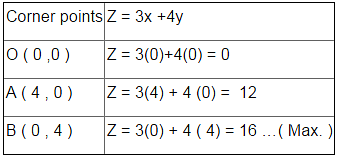JEE Exam > JEE Questions > Maximise Z = 3x + 4y subject to the constrain...
Start Learning for Free
Maximise Z = 3x + 4y subject to the constraints: x + y ≤ 4, x ≥ 0, y ≥ 0.
- a)Maximum Z = 18 at (1, 4)
- b)Maximum Z = 19 at (1, 5)
- c)Maximum Z = 16 at (0, 4)
- d)Maximum Z = 17 at (0, 5)
Correct answer is option 'C'. Can you explain this answer?
| FREE This question is part of | Download PDF Attempt this Test |
Verified Answer
Maximise Z = 3x + 4y subject to the constraints: x + y ≤ 4, x &#...
Objective function is Z = 3x + 4 y ……(1).
The given constraints are : x + y ≤ 4, x ≥ 0, y ≥ 0.

therefore Z = 16 is maximum at ( 0 , 4 ) .
The given constraints are : x + y ≤ 4, x ≥ 0, y ≥ 0.
therefore Z = 16 is maximum at ( 0 , 4 ) .
Most Upvoted Answer
Maximise Z = 3x + 4y subject to the constraints: x + y ≤ 4, x &#...
To maximize the objective function Z = 3x + 4y, we need to find the maximum value of Z subject to the given constraints.
Constraint 1: x + y ≤ 4
This constraint represents the restriction that the sum of x and y should be less than or equal to 4.
Constraint 2: x ≥ 0
This constraint represents the restriction that x should be greater than or equal to 0.
Constraint 3: y ≥ 0
This constraint represents the restriction that y should be greater than or equal to 0.
To find the maximum value of Z, we need to consider the feasible region defined by the intersection of the three constraints.
Solving the constraints:
1. For the first constraint, x + y ≤ 4, we can plot the line x + y = 4 on a graph. This line passes through the points (0, 4) and (4, 0) and divides the graph into two regions. We are interested in the region where x + y is less than or equal to 4.
2. For the second constraint, x ≥ 0, we know that x should be greater than or equal to 0. This constraint limits the feasible region to the positive x-axis and the right half of the graph.
3. For the third constraint, y ≥ 0, we know that y should be greater than or equal to 0. This constraint limits the feasible region to the positive y-axis and the upper half of the graph.
The feasible region is the intersection of the three constraints, which is the triangle formed by the points (0, 4), (4, 0), and (0, 0).
To find the maximum value of Z, we evaluate the objective function Z = 3x + 4y at the corner points of the feasible region.
Corner points of the feasible region:
1. (0, 0)
2. (0, 4)
3. (4, 0)
Evaluate Z at the corner points:
1. Z = 3(0) + 4(0) = 0
2. Z = 3(0) + 4(4) = 16
3. Z = 3(4) + 4(0) = 12
The maximum value of Z is 16, which occurs at the point (0, 4).
Therefore, the correct answer is option 'C': Maximum Z = 16 at (0, 4).
Constraint 1: x + y ≤ 4
This constraint represents the restriction that the sum of x and y should be less than or equal to 4.
Constraint 2: x ≥ 0
This constraint represents the restriction that x should be greater than or equal to 0.
Constraint 3: y ≥ 0
This constraint represents the restriction that y should be greater than or equal to 0.
To find the maximum value of Z, we need to consider the feasible region defined by the intersection of the three constraints.
Solving the constraints:
1. For the first constraint, x + y ≤ 4, we can plot the line x + y = 4 on a graph. This line passes through the points (0, 4) and (4, 0) and divides the graph into two regions. We are interested in the region where x + y is less than or equal to 4.
2. For the second constraint, x ≥ 0, we know that x should be greater than or equal to 0. This constraint limits the feasible region to the positive x-axis and the right half of the graph.
3. For the third constraint, y ≥ 0, we know that y should be greater than or equal to 0. This constraint limits the feasible region to the positive y-axis and the upper half of the graph.
The feasible region is the intersection of the three constraints, which is the triangle formed by the points (0, 4), (4, 0), and (0, 0).
To find the maximum value of Z, we evaluate the objective function Z = 3x + 4y at the corner points of the feasible region.
Corner points of the feasible region:
1. (0, 0)
2. (0, 4)
3. (4, 0)
Evaluate Z at the corner points:
1. Z = 3(0) + 4(0) = 0
2. Z = 3(0) + 4(4) = 16
3. Z = 3(4) + 4(0) = 12
The maximum value of Z is 16, which occurs at the point (0, 4).
Therefore, the correct answer is option 'C': Maximum Z = 16 at (0, 4).
Attention JEE Students!
To make sure you are not studying endlessly, EduRev has designed JEE study material, with Structured Courses, Videos, & Test Series. Plus get personalized analysis, doubt solving and improvement plans to achieve a great score in JEE.

|
Explore Courses for JEE exam
|

|
Similar JEE Doubts
Maximise Z = 3x + 4y subject to the constraints: x + y ≤ 4, x ≥ 0, y ≥ 0.a)Maximum Z = 18 at (1, 4)b)Maximum Z = 19 at (1, 5)c)Maximum Z = 16 at (0, 4)d)Maximum Z = 17 at (0, 5)Correct answer is option 'C'. Can you explain this answer?
Question Description
Maximise Z = 3x + 4y subject to the constraints: x + y ≤ 4, x ≥ 0, y ≥ 0.a)Maximum Z = 18 at (1, 4)b)Maximum Z = 19 at (1, 5)c)Maximum Z = 16 at (0, 4)d)Maximum Z = 17 at (0, 5)Correct answer is option 'C'. Can you explain this answer? for JEE 2024 is part of JEE preparation. The Question and answers have been prepared according to the JEE exam syllabus. Information about Maximise Z = 3x + 4y subject to the constraints: x + y ≤ 4, x ≥ 0, y ≥ 0.a)Maximum Z = 18 at (1, 4)b)Maximum Z = 19 at (1, 5)c)Maximum Z = 16 at (0, 4)d)Maximum Z = 17 at (0, 5)Correct answer is option 'C'. Can you explain this answer? covers all topics & solutions for JEE 2024 Exam. Find important definitions, questions, meanings, examples, exercises and tests below for Maximise Z = 3x + 4y subject to the constraints: x + y ≤ 4, x ≥ 0, y ≥ 0.a)Maximum Z = 18 at (1, 4)b)Maximum Z = 19 at (1, 5)c)Maximum Z = 16 at (0, 4)d)Maximum Z = 17 at (0, 5)Correct answer is option 'C'. Can you explain this answer?.
Maximise Z = 3x + 4y subject to the constraints: x + y ≤ 4, x ≥ 0, y ≥ 0.a)Maximum Z = 18 at (1, 4)b)Maximum Z = 19 at (1, 5)c)Maximum Z = 16 at (0, 4)d)Maximum Z = 17 at (0, 5)Correct answer is option 'C'. Can you explain this answer? for JEE 2024 is part of JEE preparation. The Question and answers have been prepared according to the JEE exam syllabus. Information about Maximise Z = 3x + 4y subject to the constraints: x + y ≤ 4, x ≥ 0, y ≥ 0.a)Maximum Z = 18 at (1, 4)b)Maximum Z = 19 at (1, 5)c)Maximum Z = 16 at (0, 4)d)Maximum Z = 17 at (0, 5)Correct answer is option 'C'. Can you explain this answer? covers all topics & solutions for JEE 2024 Exam. Find important definitions, questions, meanings, examples, exercises and tests below for Maximise Z = 3x + 4y subject to the constraints: x + y ≤ 4, x ≥ 0, y ≥ 0.a)Maximum Z = 18 at (1, 4)b)Maximum Z = 19 at (1, 5)c)Maximum Z = 16 at (0, 4)d)Maximum Z = 17 at (0, 5)Correct answer is option 'C'. Can you explain this answer?.
Solutions for Maximise Z = 3x + 4y subject to the constraints: x + y ≤ 4, x ≥ 0, y ≥ 0.a)Maximum Z = 18 at (1, 4)b)Maximum Z = 19 at (1, 5)c)Maximum Z = 16 at (0, 4)d)Maximum Z = 17 at (0, 5)Correct answer is option 'C'. Can you explain this answer? in English & in Hindi are available as part of our courses for JEE.
Download more important topics, notes, lectures and mock test series for JEE Exam by signing up for free.
Here you can find the meaning of Maximise Z = 3x + 4y subject to the constraints: x + y ≤ 4, x ≥ 0, y ≥ 0.a)Maximum Z = 18 at (1, 4)b)Maximum Z = 19 at (1, 5)c)Maximum Z = 16 at (0, 4)d)Maximum Z = 17 at (0, 5)Correct answer is option 'C'. Can you explain this answer? defined & explained in the simplest way possible. Besides giving the explanation of
Maximise Z = 3x + 4y subject to the constraints: x + y ≤ 4, x ≥ 0, y ≥ 0.a)Maximum Z = 18 at (1, 4)b)Maximum Z = 19 at (1, 5)c)Maximum Z = 16 at (0, 4)d)Maximum Z = 17 at (0, 5)Correct answer is option 'C'. Can you explain this answer?, a detailed solution for Maximise Z = 3x + 4y subject to the constraints: x + y ≤ 4, x ≥ 0, y ≥ 0.a)Maximum Z = 18 at (1, 4)b)Maximum Z = 19 at (1, 5)c)Maximum Z = 16 at (0, 4)d)Maximum Z = 17 at (0, 5)Correct answer is option 'C'. Can you explain this answer? has been provided alongside types of Maximise Z = 3x + 4y subject to the constraints: x + y ≤ 4, x ≥ 0, y ≥ 0.a)Maximum Z = 18 at (1, 4)b)Maximum Z = 19 at (1, 5)c)Maximum Z = 16 at (0, 4)d)Maximum Z = 17 at (0, 5)Correct answer is option 'C'. Can you explain this answer? theory, EduRev gives you an
ample number of questions to practice Maximise Z = 3x + 4y subject to the constraints: x + y ≤ 4, x ≥ 0, y ≥ 0.a)Maximum Z = 18 at (1, 4)b)Maximum Z = 19 at (1, 5)c)Maximum Z = 16 at (0, 4)d)Maximum Z = 17 at (0, 5)Correct answer is option 'C'. Can you explain this answer? tests, examples and also practice JEE tests.

|
Explore Courses for JEE exam
|

|
Suggested Free Tests
Signup for Free!
Signup to see your scores go up within 7 days! Learn & Practice with 1000+ FREE Notes, Videos & Tests.
























